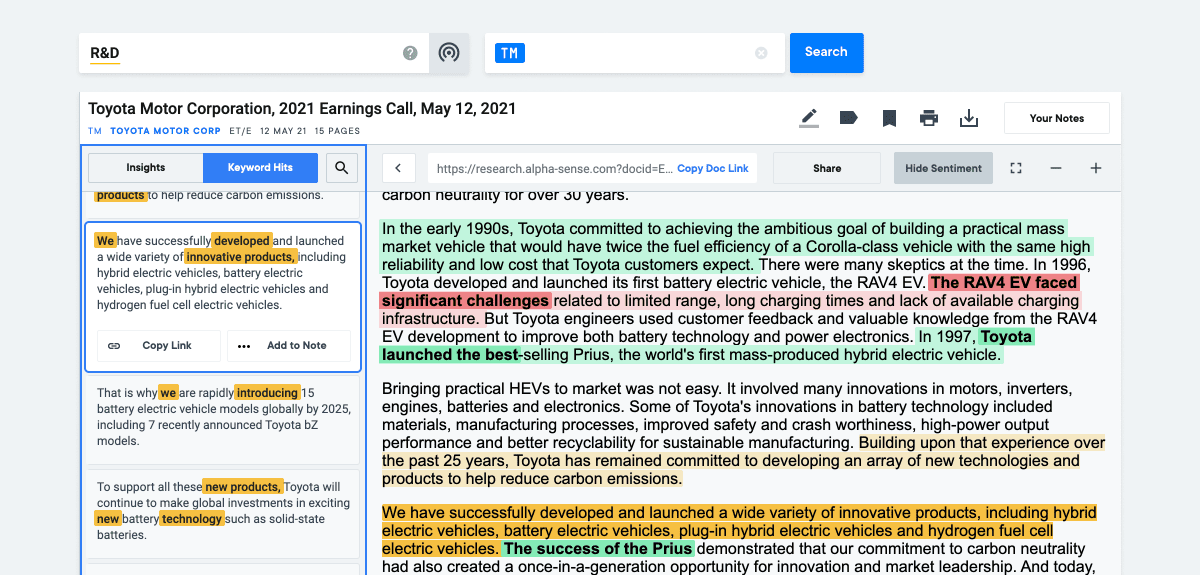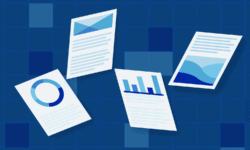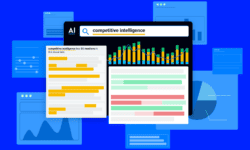In today’s fast-paced and ever-evolving business landscape, staying ahead of the competition is more challenging yet more crucial than ever. Having a dedicated and comprehensive competitor analysis framework is critical, as is the ability to access all the competitive information you need in one place.
A competitor analysis framework is a strategic tool that empowers corporations to systematically study and understand their competitors’ strengths, weaknesses, strategies, and market positioning—and then benchmark it against their own to create an effective strategy. This framework not only provides valuable insights for informed decision-making but also uncovers hidden opportunities and potential threats.
Whether you’re looking to refine your market strategy, innovate more effectively, or enhance your competitive advantage, mastering competitor analysis is your key to sustained success and growth. In this article, we’ll explore how to construct an effective competitor analysis framework by leveraging the AlphaSense platform and share best practices to ensure your business remains competitive and agile.
What is a Competitor Analysis Framework?
A competitor analysis framework is a structured approach used by businesses to systematically study, evaluate, and understand their competitors within the market. This framework involves collecting and analyzing data on competitors’ strengths, weaknesses, strategies, products, market positions, and overall performance.
The main goal of utilizing a competitor analysis framework is to gain insights that help an organization enhance its competitive advantage and make informed strategic decisions. Additionally, this structured approach is a repeatable framework that allows you to automate the competitor strategy process and avoid wasting time, while ensuring you don’t miss critical insights.
Different Types of Competitor Analysis Frameworks
There are several main types of established competitor analysis frameworks, all of which suit different purposes and use cases. The most effective method of developing your own competitor analysis framework is to consider what elements of classic frameworks best suit your business needs and then combine the most useful elements into a new, unique framework.
Established competitor analysis frameworks include:
- SWOT Analysis – An analysis of your competitors’ strengths, weaknesses, opportunities, and threats. This helps in understanding a competitor’s overall strategic position and potential areas for growth or risk.
- PEST Analysis – Stands for political, economic, social, and technological analysis. This helps provide a broader context for the external factors influencing your competitive landscape.
- Porter’s Five Forces Analysis – Examines five key forces that influence a market’s competitive intensity and attractiveness. This helps companies understand the underlying forces driving competition in their industry.
- Competitor Profiling – Involves documenting and analyzing key competitors’ strategies, resources, capabilities, and market behaviors. This provides a thorough understanding of specific competitors and helps with strategic planning.
- Perceptual Mapping – A visual representation of how consumers perceive competitors in relation to various attributes or dimensions. This helps identify market gaps and opportunities for differentiation.
Key Components of a Competitor Analysis Framework
The following are some of the key elements that should be present in a comprehensive competitor analysis framework:
- Identification of competitors – Putting together a list of both indirect and direct competitors
- Direct competitors are companies that offer similar products or services as your company, to the same target consumer audience.
- Indirect competitors are companies that offer alternative solutions to your product but target the same audience.
- Data collection – The process of gathering data needed to gain a complete picture of your competitors’ strategies, positioning, strengths, and weaknesses.
- Analysis and interpretation – Utilizing one of the frameworks listed in the above section to analyze competitors’ strategies and market positioning.
- Reporting and visualization – Utilizing tools to visualize and conceptualize the competitive landscape, such as dashboards or perceptual maps.
- Market trend analysis – Analyzing how market trends influence your competitive landscape and competitor moves.
How to Conduct a Competitor Analysis Framework
1. Identify Competitors
Start by compiling a list of your direct and indirect competitors to build out your competitive landscape. AlphaSense is an ideal tool for this, as you can search specific terms that are most relevant to your business and then see what other companies are associated with those terms based on what appears in the search results.
For example, if your business operates in the electric vehicle space, then you can identify your direct and indirect competitors by searching “EV” or “electric vehicles” in our search engine. The AlphaSense platform will populate all relevant documents on the left pane and all the Companies in Search Results on the right pane that pertain to your search.
2. Gather Data
The next step centers around accessing the right content, which allows you to get a complete picture of each of your competitors and provides you with differentiated insights that give you a competitive edge.
AlphaSense is a crucial tool in this step, as we are a one-stop shop for all the content you need to gain a 360-degree view of your competitors and market. Our content can be separated into four key perspectives—company, journalist, analyst, and expert. Diving into each of these, our content library includes:
- Company – Company documents, including earnings transcripts, press releases, financial statements, company presentations, ESG reports, and more
- Journalist – News, including top newspapers, trade publications, and regulatory governments
- Analyst – Broker research from 1,500+ top Wall Street firms in our proprietary Wall Street Insights® content offering
- Expert – Tens of thousands of expert call transcripts with prior employees, partners, customers, and competitors of any company you are interested in
Additionally, our artificial intelligence (AI) search technology and automation features accelerate and enhance your research, giving you a competitive edge. We expand on these features in greater detail below:
Semantic Search
With our AI search technology, you no longer have to manually CTRL-F through fragmented research documents and reports. Instead, our AI automatically recognizes what you are looking for and surfaces results that directly match your search intent—while filtering out the excess noise. This means you can shave hours of time off your research and be more confident in the accuracy and comprehensiveness of your results.
Our patented AI search feature, Smart Synonyms™, identifies phrases and keywords that are meaningfully related to your search query to provide you with relevant and useful data so you never miss critical insights.
Sentiment Analysis
Our sentiment analysis and natural language processing (NLP) technology analyzes how the market feels about a given company, industry, or topic. Our sentiment analysis tool color-codes positive and negative sentiment for easy recognition as you browse documents and search results in the platform. These AI features work within seconds, saving you hours previously spent combing through dozens of earnings reports.
Sentiment analysis is instrumental in earnings research, as it uncovers subtle shifts in a competing company’s messaging on relevant topics and themes.
Generative AI
Unlike other consumer-grade generative AI (genAI) tools trained on publicly available data, AlphaSense takes an entirely different approach. Our industry-leading suite of generative AI tools is purpose-built to deliver business-grade insights and leans on 10+ years of AI tech development.
Our Smart Summaries tool allows you to glean instant earnings insights—reducing time spent on research during earnings season, quickly capture company outlook, and generate an expert-approved SWOT analysis straight from former competitors, partners, and employees.
3. Conduct a SWOT Analysis
This next step involves identifying and analyzing the strengths, weaknesses, opportunities, and threats for areas of your business or your competitor’s. This enables you to develop a fact-based analysis that provides heightened clarity around not just your current position in the market, relative to your competitors, but also which future strategic investments have the potential to help you take the lead.
If we’re creating a competitive SWOT analysis, some of the factors to consider include:
- Brand recognition
- Cash flow/financing
- Financial performance (including earnings reporting, if public)
- Technological innovation (or lack thereof)
- Market penetration
- Employee retention/satisfaction
- Strategic investments (including M&A activity) and partnerships
- Relevant regulatory changes
- Competitive landscape
With AlphaSense, you can use our Notebook template to quickly and easily build a SWOT analysis for your own company, as well as for your competitors. You can also gather all the data you need to complete your analysis by using our varied content sets—company documents, news, broker research, and expert transcripts—which provide comprehensive primary and secondary research.
4. Create Battlecards
The next step is to create battlecards for your competitors. Battlecards are an essential tool within a competitive analysis framework, providing sales teams with the insights they need to navigate competitive situations effectively. An exemplary battlecard compares products and services, focuses on key competitive advantages, and provides value propositions that position a business’s product well against competitive offerings.
Companies can empower their sales teams to counter competitors and close more deals by gathering comprehensive competitor data, structuring it into actionable and easily digestible formats, and regularly updating the information. This not only improves sales performance but also reinforces the company’s competitive positioning in the market.
The information included on battlecards is highly dependent on the needs of sellers, but typically contains:
- An overview of a competitor’s products/services
- Pricing information
- Side-by-side feature comparisons
- A competitor’s relative strengths and weaknesses
- What differentiates competitors from your company
- Why customers have chosen your company over competitors (including quotes if you have them!)
With AlphaSense, you can use our Notebook template to quickly and easily create battlecards throughout your research process. Notebook also allows you to share the battlecards with your team and collaborate.
5. Market Trends Analysis
For the last step, you will be conducting a market trend analysis. A market trends analysis allows you to evaluate evolving trends within a specific market or industry, along with competitive signals and priorities. Researching and monitoring these trends allows you to identify new opportunities, make more informed (and proactive) business decisions, and stay ahead of the competition.
This could include anything from tracking consumer trends and spending patterns, to monitoring emerging technology or areas of investment, to staying on top of new regulations, bills, and budget decisions.
No matter the market you’re reviewing, the information in this analysis will likely include at least some of the following:
- A statement of market definition (scope, components, boundaries, TAM, etc)
- Emerging trends, including technological innovation, shifts in consumer behavior, and/or legal/regulatory changes
- Areas of market growth and decline
- An overview of the competitive landscape
- Economic influences (i.e., macroeconomic factors, supply chain, etc.)
- Forecast and predictions
- Recommended actions for the business to pursue
You can attain all of this information quickly and easily within the AlphaSense platform by relying on our vast content universe and generative AI features. Smart Summaries and our Trending Topics tool provide you with at-a-glance insights and summaries on key trends within any market. These essential tools can set the direction for further research in your competitor analysis.
We also offer a full suite of monitoring, analysis, and collaboration tools that allow you to monitor the market in real time and share key insights with team members. These tools extend beyond search and summarization and include:
- Customizable Dashboards create a centralized information hub for monitoring key companies and themes, while tailored real-time alerts provide real-time updates.
- Powerful collaboration tools like Notebook+ and commenting features help teams manage and share insights more effectively.
- Table Tools allow you to move faster with spreadsheet-style visualizations directly from company filings, so you can chain together, edit, and optimize tables for analysis.
- Image Search allows you to discover insights buried in charts to quickly capture data without reading through pages of documents.
- Snippet Explorer allows you to effortlessly look at any topic or theme and all its historical mentions in a single view.
- Our Black-lining feature allows you to identify any QoQ changes in SEC filings automatically.
- Automated Monitoring allows you to set up real-time alerts that send instant updates on any relevant market movements, news, emerging trends, and competitor activities. We also generate snapshots of companies and topics regularly to keep you ahead of the curve with actionable insights.
For more information on how Notebook can help you with each step of creating your competitive analysis framework, check out the 5 Competitive Intelligence Templates to Use in AlphaSense’s Notebook.
Benefits of a Competitor Analysis Framework
Understanding Market Opportunities and Threats
Having an effective and comprehensive competitor analysis framework allows you to identify any gaps in the market and potential risks for your business. This knowledge is crucial for developing and implementing an effective competitive strategy.
Developing a Proactive Strategy
In an ever-shifting and fast-moving market, simply reacting to competitor moves and market events as they occur is insufficient when aiming to outperform your competitors. Instead, your competitive intelligence should enable you to anticipate market shifts, plan for future scenarios, and generally be proactive in maintaining or gaining your competitive edge. Having a strong competitor analysis framework is critical for being proactive, rather than reactive, in your strategic approach.
Enhancing Your Competitive Advantage
When you have a clear and thorough understanding of your competitors’ strengths and weaknesses, you can fine-tune your value propositions and ensure you are playing to your company’s strengths and meeting customer needs where competitors are failing to do so.
Conducting a SWOT analysis and creating battlecards is highly effective for this reason. Clearly delineating where your competitors are winning and where they are falling short allows you to hone your own competitive advantage, and this approach is repeatable for all your indirect and direct competitors.
Improved Innovation and Product Development
A competitor analysis framework can be a useful tool for stimulating innovation and improving product development. Rather than developing products without any real strategy and relying on trial and error to see if something is working, your framework can give you an instant view into where customer needs are not being met by existing products in the market. From there, you can strategically innovate to meet those precise needs and get an edge over your competitors.
Improved Decision-Making and Risk Management
A competitor analysis framework allows you to better anticipate and prepare for competitors’ disruptive moves like price changes, new product launches, or strategic alliances. This allows for more effective contingency planning so you are never caught unawares without a strategy. And because your framework affords you critical insight into market events/trends, competitor strategies, and industry dynamics, you can make better-informed business decisions that truly move the needle.
Emerging Trends in Competitor Analysis
Emerging trends in competitive analysis reflect advancements in technology, artificial intelligence, data analytics, and strategic approaches to gaining market insights. Here are some of the top emerging trends:
Artificial Intelligence, Machine Learning (ML), and Generative AI (GenAI)
AI and ML algorithms can automate the data gathering process that is essential for competitive intelligence, thus freeing up valuable time for analysis and strategy and decreasing manual effort. AI can also be used for predictive analytics—using historical data and patterns to predict how competitors will behave or how the market will move in the future.
Today, companies that conduct the most effective competitor analysis are utilizing tools that incorporate AI and ML algorithms, which allows them to accelerate and enhance the accuracy of their research while eliminating blind spots. AlphaSense provides best-in-class AI features that truly move the needle for our customers and give them the biggest advantage.
For example, AlphaSense’s NLP-based sentiment analysis feature is a highly valuable tool in competitor analysis, as it enables you to instantly understand market and company sentiment on any particular topic, as well as how it changes over time.
Generative AI is also a critical new development in the competitive intelligence space, as it automates and speeds up various steps in the CI process and brings new possibilities for data analysis, predictive analytics, visualization, and more. AlphaSense’s Smart Summaries is our proprietary genAI tool that dramatically accelerates and enhances your competitive intelligence.
Real-Time Competitive Intelligence
With the current pace of the markets, having access to real-time insights can mean the difference between leading the fray or lagging behind the competition. With new competitors emerging every day and trends constantly shifting, using a tool that sends you real-time alerts on any and all relevant updates is crucial. AlphaSense’s automated alerts and customized watchlists ensure you never miss an update from the companies and industries that matter most to you.
Platforms that Facilitate Collaboration
What was once an individual task or something delegated to a singular team is now seen as a cross-functional effort. Companies are recognizing the necessity of providing their sales, marketing, and research and development (R&D) teams with access to competitive insights and collaborative platforms to create effective competitive strategies together.
For this reason, enterprise platforms—like AlphaSense’s Enterprise Intelligence—are highly useful, as they allow you to maintain your competitive edge by centralizing all your market intelligence and streamlining collaboration between teams. Likewise, our Notebook feature helps teams manage and share insights more effectively.
Data Security and Compliance
With new data privacy laws and regulations in competitive intelligence activities, it’s critical for companies to use tools that safeguard them against data breaches or regulatory risks. That’s why AlphaSense takes a highly comprehensive approach to security and ensures your data is protected when you use our Enterprise Intelligence platform. Additionally, when conducting primary research through our platform, you can be sure that each expert call in our expert transcript library is carefully vetted through our industry-leading compliance process.
Enhance Competitor Analysis With AlphaSense
Your competitor analysis framework is only as effective as the research tools you rely on. AlphaSense is equipped with premium content sets—company documents, broker research, news, and expert calls—and advanced AI search technology that will help you stay ahead of the curve and continue to outpace your competition.
Learn more about how AlphaSense supports corporations in creating and implementing their frameworks:
See how AlphaSense compares with other competitive intelligence platforms:
Uplevel your competitive strategy with AlphaSense. Start your free trial today.










